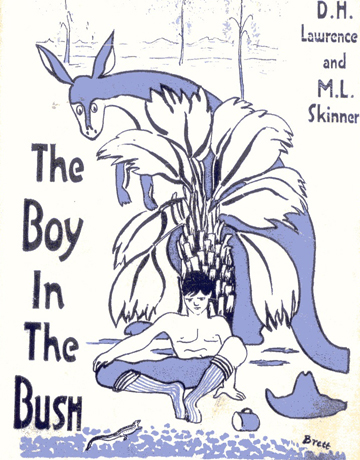
|
The
Seltzer edition of The
Boy in the Bush, with a cover by Dorothy Brett
(who lived with Lawrence in a log cabin outside
Taos, and later scrapped with Frieda over Lawrence's
ashes)
|
WHILE SANDRA
was busying herself looking into the local scene in Perth,
my attention had turned to a question that had been bothering
me for some time. What was the literary process Lawrence
was using to turn "reality" into "fiction"?
How was he going about transposing - "fictionalising"
- things he was observing and "picking up" from
his experiences and surroundings in Sydney and Thirroul
into the text of the novel that he was writing, at the rate
of up to 3000 words a day?
Fortunately, someone had written something significant on
this before.
A childhood friend of Lawrence, George Neville, who had
grown up with him in Eastwood, wrote a memoir, The Betrayal
[CUP, Cambridge 1982], in which he discussed what he described
as Lawrence's inability to invent things - particularly
the names of people he portrayed in his works.
Neville wrote:
I
have never been able to understand why Lawrence, of
whose wonderfully fertile and vivid imagination we
have such abundant proof, should so constantly refuse
to put his imagination into action when seeking names
for his characters.
|
In
The Betrayal, Neville listed more than 30 characters
in Lawrence's fiction that were not only named after people
Lawrence had known in Eastwood, but whose traits and characteristics
he sometimes also appropriated.
These included the Mellors family; the Houghtons; the
Chatterleys; and Birkin, Lawrence's violin-playing neighbour,
who became one of the main characters (and his alter
ego) in Women in Love.
Neville confronted Lawrence over this.
| I
am forcibly reminded of a discussion I had with him
in March 1912. I had raised the matter of the very
pointed references he was making, in his writings,
to living individuals, and the fact that, for the
majority of his characters, he was using the names
of actual people he knew well. |
Lawrence, reported Neville, "would not hear of any
argument" on the matter.
Neville went on to make an important observation, germane
to Kangaroo:
| In
fairness to Lawrence, I think I ought to say that
the character as portrayed by him is usually just
about as near being diametrically opposed to the character
of the actual holder of the name... |
So here was one of Lawrence's "transformation"
techniques - the "opposites" switch - that he
used to turn fact into fiction. Neville went on to identify
another, which can be termed his amalgamation technique:
| In
my own opinion he deliberately mixed up a portion
of an experience he underwent [with the description
of another, similar experience]...His works are full
of such transpositions. |
You will read a lot of critical works on Lawrence before
coming across a more pertinent comment about his writings.

|